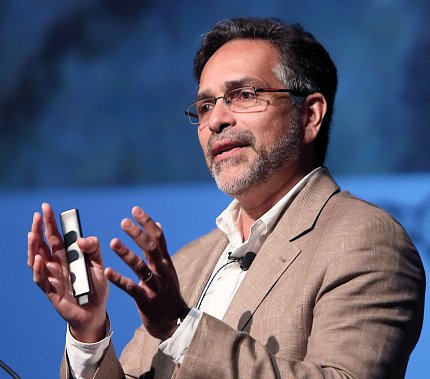What Flatworms Teach Us
Stetten Lecturer Urges Science ‘Go Out, Discover New Biology’

Photo: Chia-Chi Charlie Chang
At first glance, the planarian flatworm isn’t much to see. But its body—often a dull, mottled gray, vaguely arrow-shaped 15-millimeter squiggle, topped with two eyes that frequently appear crossed—holds a super power any other organism would envy. Planarians can regrow themselves, wholly or in part. Sliced in half, in quarters. Diced, even—same story. The loose fragments will each regenerate any of its missing elements—head, tail and any organ or system in between—and be completely like new, only multiplied.
It’s that capability that fascinates HHMI investigator Dr. Alejandro Sánchez Alvarado and his team at Stowers Institute for Medical Research. An NIGMS grantee since 1998, when he established his lab, Sánchez Alvarado discussed “Understanding the Source of Regenerative Ability in Animals,” the 2018 Dewitt Stetten Jr. Lecture on Oct. 10 at NIH.
Humans are distant cousins of planarians and several other organisms that can regenerate, argued Sánchez Alvarado. What might flatworms teach us about our own innate potential to heal ourselves?
“It’s very important to understand where we all come from,” he said. “One of the major issues associated with our understanding of biological processes—particularly developmental biology—is there’s an immense diversity of animals that appear to have shared common ancestry. We don’t understand how, from that common ancestry, they have developed this immense number of biological attributes and characteristics.”
The biomedical research enterprise has chosen to direct most of its resources toward investigating the genetic underpinnings of a relatively small number of major life forms—vertebrates such as humans, chicks, frogs, mice and zebrafish and invertebrates such as Drosophila and C. elegans, Sánchez Alvarado said. The vast majority of the research organisms used in labs today are derived essentially from one particular phylum, he pointed out.
“When you think about what these organisms have taught us, it’s immense,” Sánchez Alvarado continued. “We have invested a huge amount of time and we have learned a great deal of information, but we have selected a very small number of animals to do so…What I want to illustrate is why this actually might begin to impinge upon our ability to interrogate nature by limiting our ability to go out and discover new biology.”
Out of the roughly 9 to 10 million species recorded by the last animal inventory, the ones scientists have thoroughly investigated represent only about 0.00009 percent of organisms on the planet, Sánchez Alvarado said.
“So the question is, what are the odds that everything that we need to understand about biology would be encompassed by that 0.00009 percent? The answer is essentially zero,” he said. “The amount of information that we are ignoring—or choosing to ignore for whatever reason—is immense and is by far much bigger than anything we have learned so far. It would behoove us to try to start looking at what it is we don’t know.”

Photo: Chia-Chi Charlie Chang
Showing a list of life forms already identified on biology’s “tree of life,” Sánchez Alvarado noted the dozen or so categories of living things that scientists know hardly anything about, but that share common ancestry with us. “It’s an entire branch of our family tree that we know next to nothing about,” he lamented. “That needs to be corrected.”
The argument he usually hears in response is one of practicality, that science already has high resolution of established so-called model systems, so why attempt low resolution of what could turn out to be non-model systems?
“Think of it as mapping already-discovered continents versus discovering new continents,” counters Sánchez Alvarado. Both pursuits are equally valuable, put in perspective.
This kind of rethinking led him and his research team to consider different ways to study remarkable processes in developmental biology such as regeneration. They began examining the Schmidtea mediterranea, or flatworm planaria.
“These animals are very charismatic when you look at them under a microscope,” said Sánchez Alvarado, showing video of the drab beige cockeyed organism—magnified several-fold—in motion.
Charisma notwithstanding, flatworms share several biological attributes with humans and other organisms: They are bilaterally symmetric. Their cells have all three germ layer derivatives—ectoderm, mesoderm and endoderm. They also possess complex organ systems—central nervous system, excretory system, intricate anatomical system. Their genome too is roughly the same size as the first four human chromosomes.
In addition planarians are, in nature, “exclusively sexually reproducing and exclusively asexually reproducing animals.

Photo: Chia-Chi Charlie Chang
“The hope here,” Sánchez Alvarado explained, “was that we could begin to compare sexual reproduction to regeneration and asexual reproduction to regenesis and try to identify what may be similar or dissimilar in these processes to shed some light on the process of regeneration.”
Turns out, “a lot of the plasticity is codified in the genome of this animal,” Sánchez Alvarado said. His group has identified both the stem cells that have such remarkable flexibility—neoblasts and those that conduct the renewal process specifically—clonogenic neoblasts (cNeoblasts).
“Neoblasts are vastly more heterogeneous than anybody had ever anticipated,” Sánchez Alvarado explained.
His team has also been able to purify live cNeoblasts, provide an initial line of evidence of the transcriptional plasticity properties of neoblasts, and, for the first time ever, culture planarians’ cell division in a petri dish.
Concluding his talk, Sánchez Alvarado said his group’s next tasks—isolation of adult pluripotent stem cells—will allow even more detailed characterization of cNeoblasts’ genomic output. In addition, performing systematic cell cultures will offer further opportunity to manipulate the cells’ properties and behavior and perhaps usher in use of new technologies such as CRISPR cas9 “that we really need to continue to interrogate this biology.”
